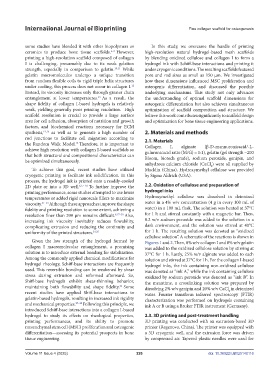Page 234 - v11i4
P. 234
International Journal of Bioprinting Fine collagen scaffold for osteogenesis
some studies have blended it with other biopolymers or In this study, we overcame the hurdle of printing
ceramics to produce bone tissue scaffolds. 6–9 However, high-resolution natural hydrogel-based mesh scaffolds
printing a high-resolution scaffold composed of collagen by blending oxidized cellulose and collagen I to form a
I is challenging, presumably due to its weak gelation hydrogel ink with Schiff-base interactions and printing it
strength, especially in comparison to gelatin. 10,11 While under cryogenic conditions. The resulting scaffolds featured
gelatin macromolecules undergo a unique transition pore and rod sizes as small as 150 μm. We investigated
from random flexible coils to rigid triple helix structures how these dimensions influenced MSC proliferation and
under cooling, this process does not occur in collagen I. osteogenic differentiation, and discussed the possible
12
Instead, its viscosity increases only through greater chain underlying mechanisms. This study not only advances
13
entanglement at lower temperatures. As a result, the the understanding of optimal scaffold dimensions for
shape fidelity of collagen I-based hydrogels is relatively osteogenic differentiation but also achieves simultaneous
weak, yielding generally poor printing resolution. High optimization of scaffold composition and structure. We
scaffold resolution is crucial to provide a large surface believe this work contributes significantly to scaffold design
area for cell adhesion, absorption of nutrition and growth and optimization for bone tissue engineering applications.
factors, and biochemical reactions necessary for ECM
synthesis, 14,15 as well as to generate a high number of 2. Materials and methods
rod junctions to facilitate cell migration according to 2.1. Materials
the Random Walk Model. Therefore, it is important to Collagen I, alginate (β-D-mannuronicacid/-L-
16
achieve high resolution with collagen I-based scaffolds so guluronicacid ratio (M/G) = 1:1), gelatin (gel strength ~200
that both structural and compositional characteristics can Bloom, biotech grade), sodium peroxide, genipin, and
be optimized simultaneously.
anhydrous calcium chloride (CaCl ) were all supplied by
2
To achieve this goal, recent studies have utilized Macklin (China). Hydroxymethyl cellulose was provided
cryogenic printing to facilitate ink solidification. In this by Sigma Aldrich (USA).
process, the hydrogel ink is printed onto a readily-cooled
2D plate or into a 3D well. 6,17–20 To further improve the 2.2. Oxidation of cellulose and preparation of
printing performance, some studies attempted to use lower hydrogel inks
temperatures or added rigid nanoscale fillers to maximize Hydroxymethyl cellulose was dissolved in deionized
viscosity. 21–23 Although these approaches improve the shape water in a 4% w/v concentration (4 g in every 100 mL of
fidelity and printing resolution to some extent, achieving a water) in a 100 mL flask. The solution was heated at 37°С
resolution finer than 200 μm remains difficult. 6,17–20 Also, for 1 h and stirred constantly with a magnetic bar. Then,
increasing ink viscosity inevitably reduces flowability, 0.2 w/v sodium peroxide was added to the solution in a
complicating extrusion and reducing the continuity and dark environment, and the solution was stirred at 40°С
uniformity of the printed structures. 24,25 for 1 h. The resulting solution was denoted as “oxidized
cellulose solution”. A schematic of the reactions is shown in
Given the low strength of the hydrogel formed by Figures 1 and 2. Then, 8% w/v collagen I and 8% w/v gelatin
collagen I macromolecular entanglement, a promising was added to the oxidized cellulose solution by stirring at
solution is to introduce external bonding for stabilization. 37°С for 1 h. Lastly, 25% w/v alginate was added to each
Among the commonly applied chemical modifications for solution and stirred at 37°С for 1 h. For the collagen I-based
hydrogel rheology, Schiff-base interactions are frequently hydrogel inks, the ink containing non-oxidized cellulose
used. This reversible bonding can be weakened by shear was denoted as “ink A,” while the ink containing cellulose
stress during extrusion and reformed afterward. So, oxidized by sodium peroxide was denoted as “ink B”. In
Shiff-base hydrogels exhibit shear-thinning behavior, the meantime, a crosslinking solution was prepared by
maintaining both flowability and shape fidelity. Some dissolving 2% w/v genipin and 20% w/v CaCl in deionized
26
2
recent studies have applied Shiff-base interactions to water. Fourier transform infrared spectroscopy (FTIR)
gelatin-based hydrogels, resulting in increased ink rigidity characterization was performed on hydrogels containing
and mechanical properties. 27–30 Following this principle, we ink A or B using a Bruker FTIR instrument (Germany).
introduced Schiff-base interactions into a collagen I-based
hydrogel to study its effects on rheological properties, 2.3. 3D printing and post-treatment handling
printing performances, and its ability to promote 3D printing was conducted with an extrusion-based 3D
mesenchymal stem cell (MSC) proliferation and osteogenic printer (Regenovo, China). The printer was equipped with
differentiation—assessing its potential prospects in bone a 3D cryogenic well, and the extrusion force was driven
tissue engineering. by compressed air. Tapered plastic needles were used for
Volume 11 Issue 4 (2025) 226 doi: 10.36922/IJB025140116

